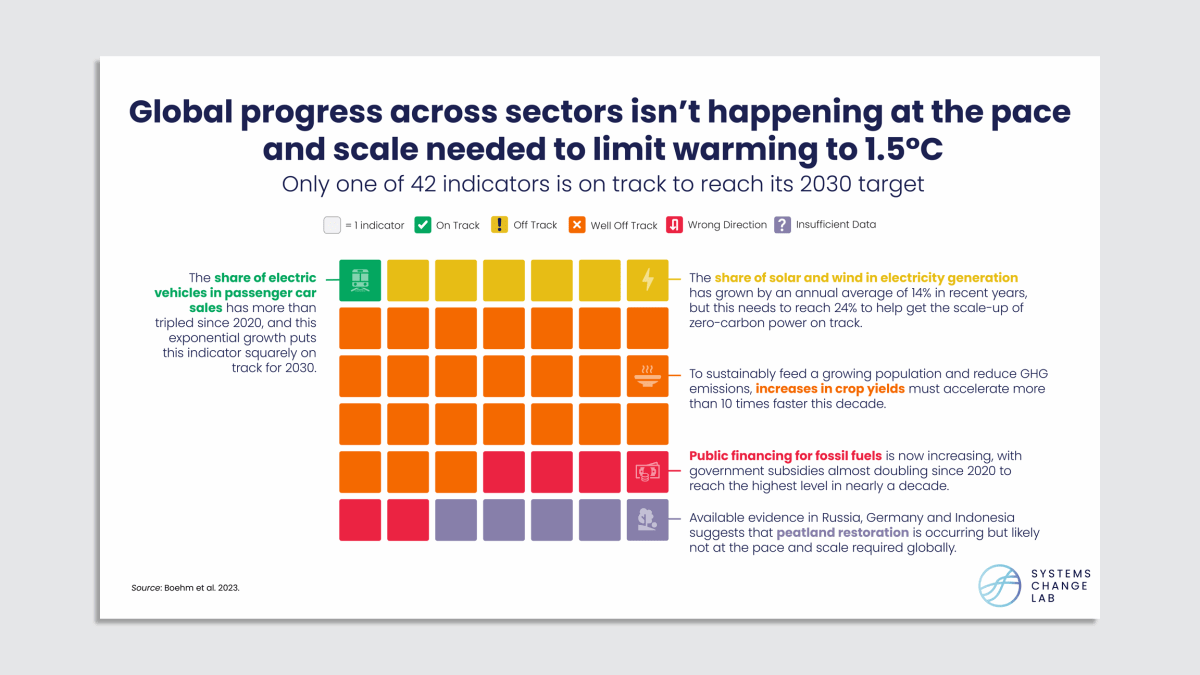There are only 7 years left to cut global emissions in half. So far, we’re failing
By 2030, to avoid some of the worst impacts of climate change, global emissions need to be 43% lower than they were in 2019—a massive drop. That’s necessary to have a chance of limiting global warming to 1.5 degrees Celsius, a goal that a U.N. climate report said was critical in 2018. At the time, news headlines talked about having 12 years left to cut emissions in half. Now there are only seven years left (or fewer, if you assume that most changes need to be in place by the beginning of 2030). That’s a little more than 80 months to transform the entire economy.
A new “State of Climate Action” report looks at how each sector of the economy is faring on the 2030 goal. The report says that only one key indicator is on track: Electric car sales are increasing quickly enough to meet the 2030 target. Forty-one other indicators—from how quickly we’re phasing out coal power to how many bike lanes we’re building—are either moving too slowly or in the wrong direction.

The world needs to be building rapid transit infrastructure six times faster, for example. The largest cities will need to add around 800 miles of train tracks and bus lanes every year, the equivalent of collectively building public transit systems triple the size of New York City’s every year for the rest of the decade. We need to build bike lanes more than 10 times faster than the current pace. Airplanes need to move from using virtually no sustainable aviation fuel now (0.1%) to 13% by 2030.
Solar and wind power are growing quickly, at an annual average of 14% per year, but that needs to jump up to 24% growth to be on track. (Relying on economics isn’t enough: Solar and wind are now the cheapest source of new electricity in most locations but still need more of a push.) Coal power needs to be phased out seven times faster, a rate equivalent to closing 240 power plants every year through 2030.
In countries with high meat consumption, such as the U.S., the shift to more sustainable diets with less beef—down to around two servings per person week—needs to happen eight times faster. Globally, meat production needs to become more efficient, which means more production on less land. Crop yields need to increase 10 times faster this decade than current rates. Deforestation, much of which is driven by agriculture, needs to decrease dramatically. Reforestation needs to happen 1.5 times more quickly.
Industry is beginning to change: Over the past two years, steel companies have announced nearly 30 new projects running on green hydrogen. Multiple startups are working on low-carbon or even zero-carbon cement. But green hydrogen production needs to accelerate significantly to be on track, and the carbon intensity of cement production needs to drop 10 times faster.
Despite the large gaps, it’s still possible to change. “The good news: The targets in the report are entirely feasible,” says Kelly Levin, chief of science, data, and systems change at Bezos Earth Lab, one of the groups behind the report. “The more challenging news: Their adoption is far from inevitable. It will require we fully dedicate ourselves to scaling action and increase investment, adopt smarter regulations and policies, and lead courageously, among other factors.”
COP28, the global climate conference that will begin at the end of this month, is a critical moment for climate action, Levin says. Countries need to recommit to ambitious national goals to cut emissions.
“This moment should serve as a springboard for accelerated actions to mitigate climate change, including a commitment for equitably phasing out fossil fuels and scaling renewable energy, transforming food systems while halting and reversing deforestation, and scaling and shifting finance,” she says. “We have a precious moment right now to choose to ignite widespread change to stop the relentless drumbeat of climate extremes and impacts unfolding around the world.”
In a new series, Fast Company will dig into what needs to happen in specific sectors to meet the 2030 goal, and will look at some of the startups that could help make it possible.
(22)



